Current state of knowledge of effects of offshore renewable energy generation devices on marine mammals and research requirements
The report describes the current state of knowledge of effects of offshore renewable energy devices on marine mammals and then identifies a prioritised list of research gaps.
9 Appendix 3. Species List
Marine mammals of direct interest in Scottish waters are listed below with brief summaries of population structure and abundance where estimates are available.
9.1 Seals
9.1.1 Harbour seal
Harbour seals ( Phoca vitulina) are widespread around the west coast of Scotland and throughout the Hebrides and Northern Isles. On the east coast, their distribution is more restricted with concentrations in the major estuaries of the Thames, The Wash, Firth of Tay and the Moray Firth. Approximately 26,000 harbour seals were counted in the U.K. up to 2012, giving an estimated total population of 36,500. Scotland holds approximately 80% of the UK harbour seal population, with 15% in England and 5% in Northern Ireland. Approximately 30% of European harbour seals are found in the UK; this proportion has declined from approximately 40% in 2002.
Major declines have now been documented in harbour seal populations around Scotland with declines since 2000 of 66% in Orkney, 50% in Shetland, 36% in the Outer Hebrides, 46% in the Moray Firth and 84% in the Firth of Tay. These declines are not thought to be linked to the 2002 Phocine Distemper Virus (PDV) epidemic that seems to have had little effect in Scotland.
This map shows the number and distribution of harbour seals in the 8 seal Management Areas around the coast of Scotland during the summer months, from surveys carried out between August 2007 and 2011.
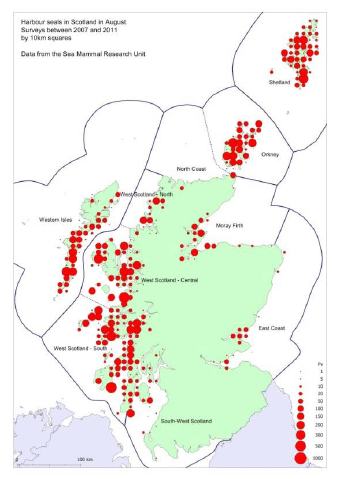
9.1.2 Grey seal
Approximately 38% of the world's grey seals ( Halichoerus grypus) breed in the UK and 88% of these breed at colonies in Scotland with the main concentrations in the Outer Hebrides and in Orkney. There are also breeding colonies in Shetland, on the north and east coasts of mainland Britain and in SW England and Wales. Although the number of pups throughout Britain has grown steadily since the 1960s when records began, there is clear evidence that the growth is levelling off in all areas except the central and southern North Sea where growth rates remain high. The numbers born in the Hebrides have remained approximately constant since 1992 and growth has been levelling off in Orkney since the late 1990s.
The most recent UK grey seal pup production estimate in 2010 was approximately 50,000 (approx. 44,000 in Scotland) which produces an estimated all age UK grey seal population of approximately 104,000 (95% CI 85,300-130,000).
This map shows the number and distribution of grey seals in Management Areas around the coast of Scotland during the summer months, from surveys carried out between August 2007 and 2011. All areas were surveyed by helicopter using a thermal imaging camera.
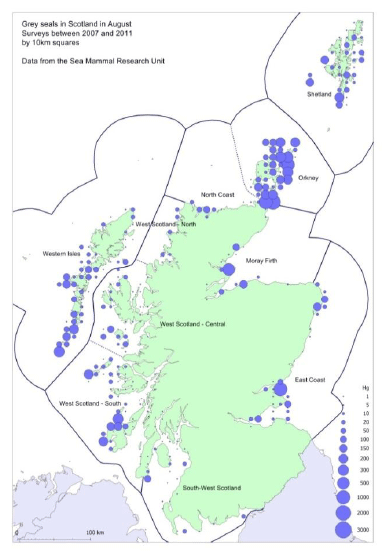
9.2 Cetaceans
9.2.1 Harbour porpoise
Harbour porpoises ( Phocoena phocoena) occur throughout Scottish waters. Population estimate from the SCANS-II survey for waters from Loch Sunart to Fraserburgh and north to 62 o was around 60,000 animals and coastal waters from Fraserburgh to Norfolk held around 17,000 animals. No estimate is available for the west coast/Inner Hebrides population.
Porpoises from the North Sea and Southwest England demonstrate genetic differences (Walton 1997; Tolley & Rosel 2006). An ASCOBANS-HELCOM workshop (Evans & Teilmann 2009) has suggested two populations in the North Sea (North and West as one and South and East as the other), and has further suggested a Northwest Ireland and West Scotland ("NWIS") management unit. (ICES 2012) preferred to keep the entire North Sea as one management unit, but maintained the "NWIS" unit. Norwegian and British North Sea animals exhibit some degree of difference (Tolley & Rosel 2006; De Luna et al. 2012).
Few studies have looked at Scottish west coast porpoises from a population genetics perspective, and relatedness of Scottish west coast animals to other groups is unclear. Walton (1997) found no significant difference between North Sea and Western Scottish animals, nor any difference between Western Scottish and Celtic Sea animals, but sample size was small.
The distribution map below is taken from Reid et al. 2003.
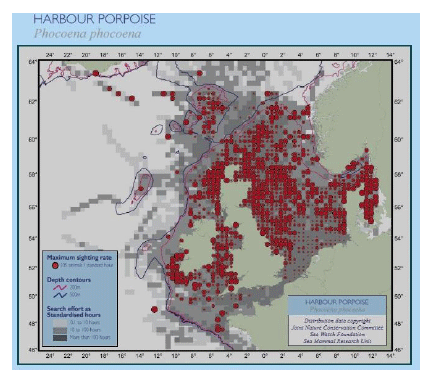
9.2.2 Bottlenose dolphin
There are two local populations of bottlenose dolphins ( Tursiops truncatus) in Scottish waters; an east coast group centred on the Moray Firth and a West Coast group. Although both Moray Firth' and west of Scotland animals do occur outside their 'normal' home ranges, these can be regarded as two discrete stocks. The total population in Scottish waters is around 200-300 individuals with around 80% along the east coast and 20% along the west coast population (Thompson et al. 2011 ). There are sightings of animals in the central North Sea which may also be from the same population, though none has been photo-identified to our knowledge.
Although genetic data indicated that the Moray Firth population is more closely related to Welsh animals than to West coast of Scotland animals (Parsons et al. 2002) suggesting little or no mixing of east and west coast animals, photo-identification data from multiple studies have also shown that coastal bottlenose dolphins do move between the east and west coast of Scotland and between Scottish and Irish waters (Thompson et al 2011; Robinson et al. 2009). There is some evidence that there may be two or more 'communities' of dolphins on the West coast, one centred around the Sound of Barra, and the other in the Inner Hebrides with sightings from Kintyre to Gairloch, and some suggestion of further partitioning of the inshore habitat among two groups of individuals. Bottlenose dolphins also occur further offshore and beyond the 200nm limit; we don't know how much mixing there is between the two inshore populations and those animals further offshore, nor do we know how animals sighted in Northern Scotland or the central North Sea relate to other groups.
The distribution map below is taken from Reid et al. 2003.
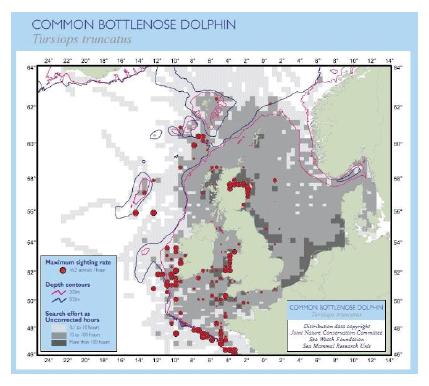
9.2.3 Minke whale
Minke whales ( Balaenoptera acutorostrata) occur throughout Scottish waters. Population estimate from the SCANS-II survey for waters from Loch Sunart to Fraserburgh and north to 62 o was around 3,000 animals and coastal waters from Fraserburgh to Norfolk held around 1,000 animals. No estimate is available for the west coast/Inner Hebrides population. There is some evidence of population sub-structure (Anderwald et al. 2011) but this is not at present taken into account in management decisions. Although there is evidence that some individual minke whales return to the same area in different years (Northridge et al 2010), these animals range over large distances and the population is treated by the IWC as a single Northeast Atlantic stock. The latest abundance estimate is around 174,000 individuals in the Central and NE Atlantic combined (IWC 2012 Website).
The map below is taken from Hammond et al. (2010) and shows the results of a spatial model prediction of minke abundance in the coloured (surveyed) area covered by SCANSII, CODA and TNASS. The line transect survey estimate of abundance for this region was about 38,000 animals (CI: 27-54 000)
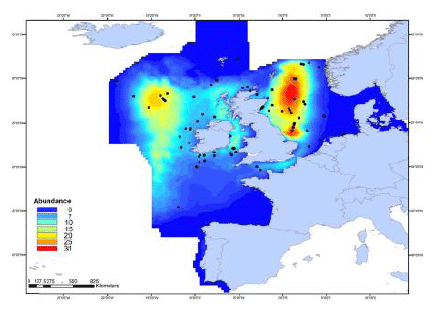
9.2.4 White beaked dolphin
White beaked dolphin (Lagenorhynchus albirostris) occurs throughout Scottish waters. Population estimate from the SCANS-II survey for waters from Loch Sunart to Fraserburgh and north to 62 o was around 1150 animals and coastal waters from Fraserburgh to Norfolk held around 2350 animals. No estimate is available for the west coast/Inner Hebrides population. Individuals are likely to be found inside and outside of the 200nm limit, but the bulk of the BI management stock is likely found inside the UK and Irish 200nm limits, and the with the majority of these inside the Scottish 200nm limit. Total abundance on European shelf waters was estimated at around 22,700 animals (Hammond et al. 2010). Sightings data suggest a population centred on Scottish waters (North Sea and West coast), extending further south into the North Sea with a distinct hiatus between Scottish and Norwegian waters. (Northridge et al 1997). A more recent study on white-beaked dolphin genetics also suggests some genetic difference between UK and Norwegian waters (Banguera-Hinestroza et al. 2010). However, ICES' WGMME recommends treating animals around the British Isles and in the North Sea as a single management unit (ICES 2012 in prep).
The distribution map below is taken from Reid et al. 2003.
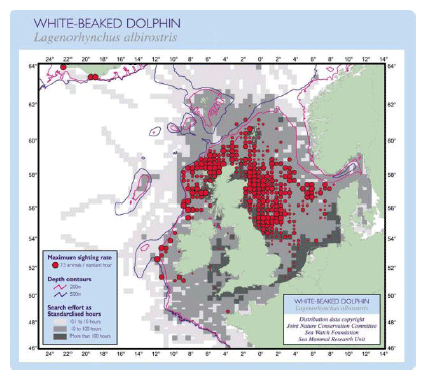
9.2.5 White sided dolphin
No evidence of local Scottish population of White sided dolphin ( Lagenorhynchus acutus). This species is mainly distributed offshore in the northeast Atlantic (Northridge et al. 1997) and is abundant throughout its range. There are an estimated 96,000 (CV=54%) off the west coast of Scotland (MacLeod 2004 ) comprising around 21,000 to the west of the Outer Hebrides and 75,000 in the Faroe Shetland Channel. (MacLeod 2004). No overall, UK or Scottish estimate is available. Population genetics work suggests a single wide-ranging population in the north-eastern Atlantic (Mirimin et al. 2011) but there is some suggestion of slight differences between animals from the North Sea and further west (Banguera-Hinestroza 2010).
The distribution map below is taken from Reid et al. 2003.
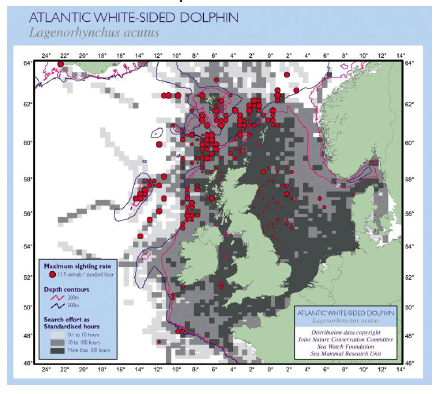
9.2.6 Killer whale
There appears to be a single population of killer whales ( Orcinus orca) around the British Isles. Abundance near UK is unknown. Much of the UK 'population' appears to occur in Scottish waters, notably the Hebrides and Shetland. A recent analysis of Killer Whale population genetics found three significantly differentiated populations centred on Iberia, the British Isles and Norway/Iceland, with some overlap between the last two around Shetland (Foote et al. 2009). Line-transect surveys have resulted in estimates of abundance in several regions in the North Atlantic, including approximately 3,100 in Norwegian waters, and 6,600 in Iceland and Faroe Islands waters (Taylor et al. 2008).
The distribution map below is taken from Reid et al. 2003.
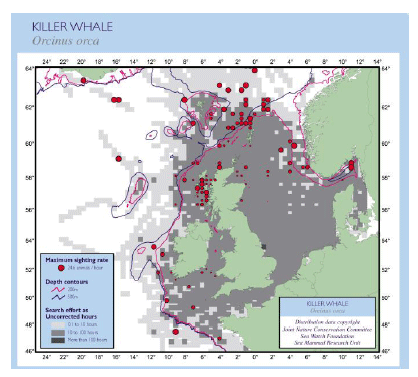
9.2.7 Risso's dolphin
Some discrete groups of Risso's dolphin ( Grampus griseus) are well known around Britain, especially one resident community in the Western Isles, off Lewis. But, sightings actually found throughout western Isles and Minch. There are also sightings around Shetland and a few in North Sea. (Reid, Evans & Northridge 2003). Results of one population genetics study found limited genetic variability among 18 samples collected from Orkney, the west coast, Wales and southern England, suggesting "that the UK Risso's dolphin population should be identified as a separate management unit when considering conservation Strategies" (Gaspari, Airoldi & Hoelzel 2007).
The distribution map below is taken from Reid et al. 2003. There is no current population estimate for UK waters.
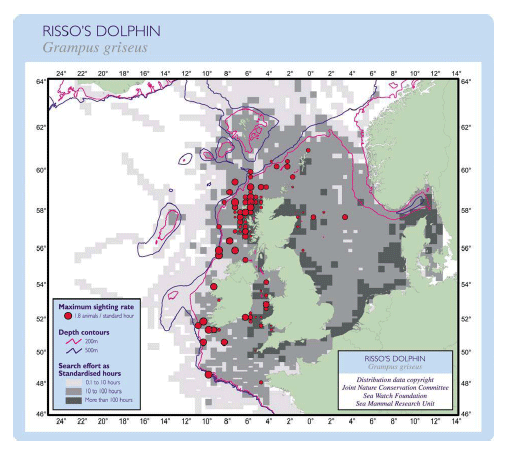
9.2.8 Common dolphin
Common dolphins ( Delphinus delphis) are regularly sighted in the Minches and occasionally further east ( e.g. sightings in Orkney in summer 2012). This population is wide ranging from Portugal to Norway and mainly in deeper water; they are more abundant on the shelf in winter, but more common in Scotland in summer. No local populations known. Around 345,000 common dolphins (including sightings characterised as common or striped) estimated by SCANS-II and CODA in the North Atlantic. Population structure has been subject of recent examination by ICES and by ASCOBANS and has been classed as a single NE Atlantic stock between Scotland and Portugal.
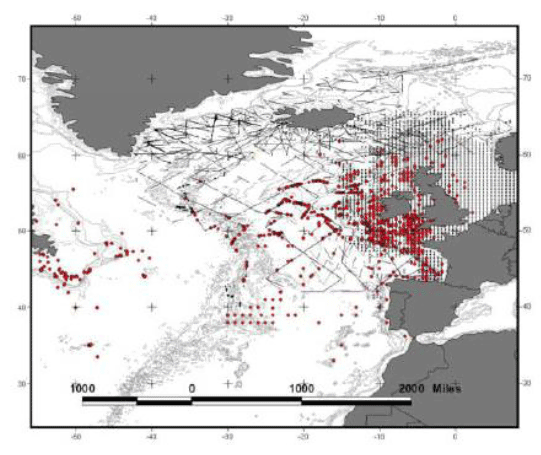
9.2.9 Other cetacean species
Other cetacean species sighted occasionally in Scottish waters include:Long finned pilot whales Globicephala melas
Striped dolphin Stenella coeruleoalba
Fin whale Balaenoptera physalus
Sei whale Balaenoptera borealis
Humpback whale Megaptera novaeangliae
Sperm whale Physeter macrocephalus
Sowerby's beaked whale Mesoplodon bidens
Contact
There is a problem
Thanks for your feedback